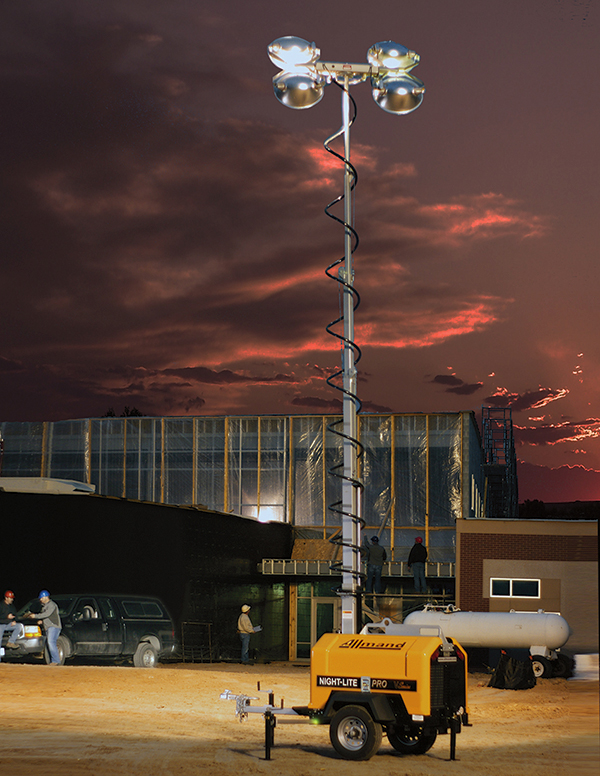On any worksite, the most important element is the safety of the workers and nearby pedestrians. It is essential to make sure the product you choose to light your worksite is set up correctly to provide adequate light and not cause any hazards. It is also important to position and adjust the lights correctly to avoid blinding workers or creating a glare hazard for nearby motorists. Some companies may claim to have non-glare light towers, but while there are ways to make the light less invasive, there is really no such thing as a truly glare-free light tower. Any type of light that is shined into a person’s eyes is going to cause glare and become a safety issue. Some models allow for all of their lights to be aimed directly down for critical applications to prevent the light from blinding those on or near the worksite. Visor shields are also offered by some manufacturers in order to shield passers-by from some of the light while providing adequate illumination of the work area.
Resources
One of the key factors to consider is the amount of light required on a worksite. The American National Standards Institute and OSHA have guidelines that specify safe lighting requirements for worksites. Once these requirements are determined, you can figure out which light tower will be able to provide the appropriate amount of light. Most light tower manufacturers are also happy to help with this process. They can often provide photometric data and charts to help you determine how much area a particular light tower can illuminate to a foot-candle level.

Metal Halide vs. LED
The “green” epidemic has led the light tower industry to begin offering light towers with LED lighting systems and those with the traditional metal halide lights. Along with being more power efficient, LED lights have advantages such as instant start and restrike. Metal halide lamps can take up to five minutes to start and five to ten minutes to restrike. LED lights also have a longer estimated life than metal halide lamps. On the other hand, LED lighting systems typically cost much more than conventional metal halide systems, and metal halide lamps produce, on average, more lumens per watt than LED lamps. This means that you are going to pay more for an LED light and probably get less light.
Environmental Safety Features
Protecting sensitive environments is always a concern. A fluid containment system capable of holding at least 110 percent of the fuel and crankcase oil in the light tower can help prevent spills. Fuel capacity is also an important factor when choosing a light tower. For light towers on especially large or remote sites and for those that are in other difficult-to-access locations, it can be beneficial for a light tower to have a larger-than-usual fuel capacity. This will lessen the number of times a fuel truck has to service them. Some manufacturers offer fuel tanks with 100 gallons of capacity, allowing the light tower to operate for extended periods before refueling. This kind of savings can add up quickly on large and remote sites.
Another worksite element to consider is wind. Some manufacturers offer four- and sometimes five-point stabilizer systems to ensure that a light tower can remain operational in gusts of up to 65 miles per hour. Without adequate stability, the tower runs the risk of being blown over, causing damage to itself, other equipment or workers and pedestrians.
The worksite can also affect the requirements for the light tower’s engine and generator size. Considering the amount of light and power required for the application, light tower manufacturers offer generators ranging from six to 20 kilowatts. The power required to operate the lights and the capability of the engine or generator can be selected to provide auxiliary power as necessary to run a trailer, water pump or other equipment. For instance, if a particular light tower takes six kilowatts of power to run and you want to use the generator to run power tools, a 20-kilowatt generator would most likely work. Make sure to let the manufacturer know what the generator will be used for.
There are three core questions to ask when choosing a light tower. First, ask for lumen output, and specify how much light you need to illuminate your worksite. Second, ask for photometric charts, or use a light tower configuration app to visualize your worksite and determine how many light towers will be required. Third, ask about additional safety and efficiency features that light tower manufacturers offer. These features can save time and money and improve the safety of the site.
Online Resource
Another way to determine the type and number of light towers required on a worksite is to download the Allmand light tower configuration app available for the iPhone and iPad. This app uses Google Maps to identify the area that needs to be illuminated. Once the site is mapped out, you can choose from 1000-watt or 1250-watt metal halide light sources with two, four or six light configurations and illuminate the space with the appropriate type and number of light towers. Although this app was developed by Allmand, it can be used as a basis for setting up any typical 1,000- or 1,250-watt metal halide light tower.
The app also includes a flashlight mode to help with your much smaller illumination needs.
